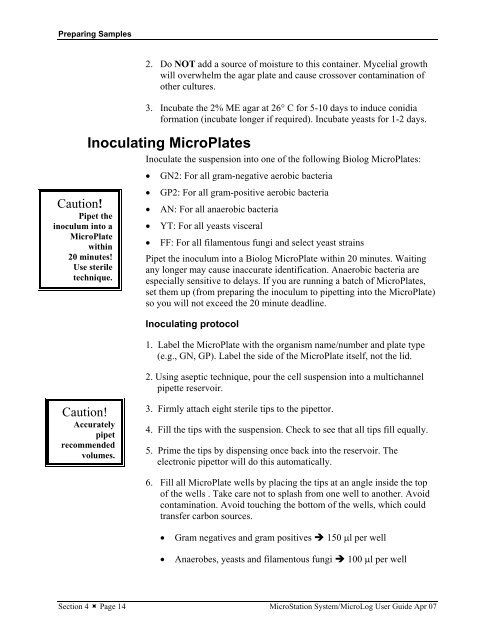MicroStation System, MicroLog Version 4.2 - DTU Systems Biology ...
MicroStation System, MicroLog Version 4.2 - DTU Systems Biology ...
MicroStation System, MicroLog Version 4.2 - DTU Systems Biology ...
You also want an ePaper? Increase the reach of your titles
YUMPU automatically turns print PDFs into web optimized ePapers that Google loves.
Preparing Samples<br />
Caution!<br />
Pipet the<br />
inoculum into a<br />
MicroPlate<br />
within<br />
20 minutes!<br />
Use sterile<br />
technique.<br />
2. Do NOT add a source of moisture to this container. Mycelial growth<br />
will overwhelm the agar plate and cause crossover contamination of<br />
other cultures.<br />
3. Incubate the 2% ME agar at 26° C for 5-10 days to induce conidia<br />
formation (incubate longer if required). Incubate yeasts for 1-2 days.<br />
Inoculating MicroPlates<br />
Inoculate the suspension into one of the following Biolog MicroPlates:<br />
• GN2: For all gram-negative aerobic bacteria<br />
Caution!<br />
Accurately<br />
pipet<br />
recommended<br />
volumes.<br />
• GP2: For all gram-positive aerobic bacteria<br />
• AN: For all anaerobic bacteria<br />
• YT: For all yeasts visceral<br />
• FF: For all filamentous fungi and select yeast strains<br />
Pipet the inoculum into a Biolog MicroPlate within 20 minutes. Waiting<br />
any longer may cause inaccurate identification. Anaerobic bacteria are<br />
especially sensitive to delays. If you are running a batch of MicroPlates,<br />
set them up (from preparing the inoculum to pipetting into the MicroPlate)<br />
so you will not exceed the 20 minute deadline.<br />
Inoculating protocol<br />
1. Label the MicroPlate with the organism name/number and plate type<br />
(e.g., GN, GP). Label the side of the MicroPlate itself, not the lid.<br />
2. Using aseptic technique, pour the cell suspension into a multichannel<br />
pipette reservoir.<br />
3. Firmly attach eight sterile tips to the pipettor.<br />
4. Fill the tips with the suspension. Check to see that all tips fill equally.<br />
5. Prime the tips by dispensing once back into the reservoir. The<br />
electronic pipettor will do this automatically.<br />
6. Fill all MicroPlate wells by placing the tips at an angle inside the top<br />
of the wells . Take care not to splash from one well to another. Avoid<br />
contamination. Avoid touching the bottom of the wells, which could<br />
transfer carbon sources.<br />
• Gram negatives and gram positives � 150 µl per well<br />
• Anaerobes, yeasts and filamentous fungi � 100 µl per well<br />
Section 4 � Page 14 <strong>MicroStation</strong> <strong>System</strong>/<strong>MicroLog</strong> User Guide Apr 07


